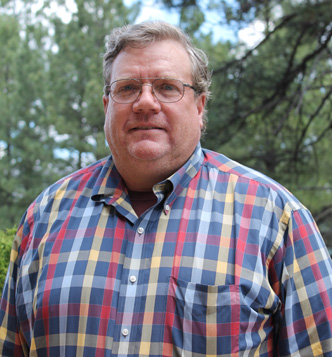Derrick Stone fills a flannel shirt like a man who knows about hard work and an outdoor lifestyle. He speaks the way he tackles a job, straight up without much flourish.
That is, until he starts to tell you about his experience as a research subject in the Center for Bioengineering Innovation at Northern Arizona University.
In December 2008, Stone lost his lower right leg to a hunting accident. Ultimately, that didn’t slow him down as a ranch hand or outdoor enthusiast. But it did allow him to develop a perspective that makes him ideal as someone to test a bionic ankle for Regents’ Professor Kiisa Nishikawa’s team and industry collaborator, BiOM.
“I had seen videos about the BiOM foot, and I thought, ‘Man, would it be nice to have an ankle again,’” Stone said. “Having gone through this and knowing what it took to walk again, I was interested in how something like this bionic foot would change things. So I said sure, it’s worth a shot. And if it would help anybody, it would be even better.”
Stone began working with the NAU team in spring 2014. After an initial assessment, he began walking with the BiOM ankle. The researchers would pore over the results and make adjustments between visits. Some sessions took two hours, and during others Stone would walk on different surfaces over the course of an eight-hour day.
As the researchers honed their algorithm for the ankle, Stone’s experience improved.
“The first day we took it outside to do the ramps it was exciting to walk more than 40 yards at a time,” Stone said. And now, with the very latest version of the algorithm in place, Stone said, “It’s like having your natural body part back. You know it’s not, but man, it sure feels good.”
Stone said the static prosthetic he uses every day does not prevent him from being active, but there are challenges.
“I have to do things slower,” he said. “I have to pay attention to what’s in front of this particular foot because I can’t feel anything until I actually hit it.”
But with the bionic ankle, “I can put my foot down and my ankle can roll,” Stone said. “If I inadvertently step on a rock, my foot rolls over. It’s about the closest thing you can get to having your foot back.”
While much work remains to refine the bionic ankle’s performance, including the algorithm that guides it, Stone is ready for more. Bring on the cinders, gravel, curbs and artificial turf, all of which can befuddle even the best adaptive prostheses.
“I’ll keep doing this for as long as they want me,” Stone said. “They’re a fun team and they’re very professional about it. There are always different programs we are going through, and I think it’s just cool.”
The researchers share in his sentiment.
“When Derrick came to try on the prosthesis with our software for the first time, he never wanted to take it off,” said Anthony Hessel, a doctoral student in biology and member of the research center. “It feels good to be part of the team that brings this opportunity to him.”



